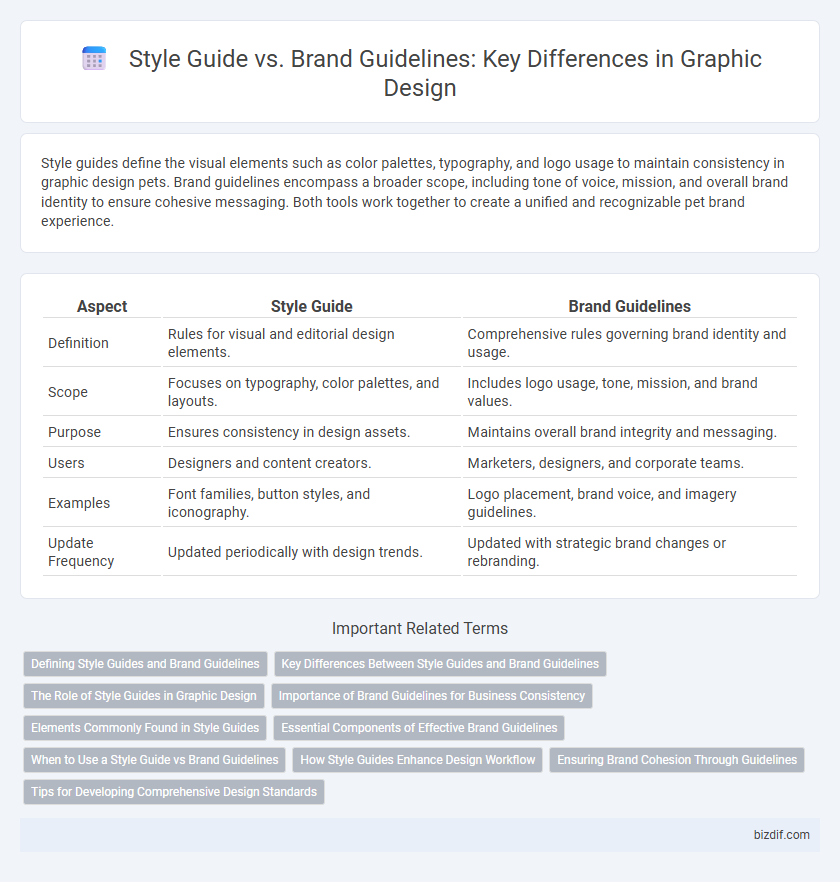Style guides define the visual elements such as color palettes, typography, and logo usage to maintain consistency in graphic design pets. Brand guidelines encompass a broader scope, including tone of voice, mission, and overall brand identity to ensure cohesive messaging. Both tools work together to create a unified and recognizable pet brand experience.
Table of Comparison
| Aspect | Style Guide | Brand Guidelines |
|---|---|---|
| Definition | Rules for visual and editorial design elements. | Comprehensive rules governing brand identity and usage. |
| Scope | Focuses on typography, color palettes, and layouts. | Includes logo usage, tone, mission, and brand values. |
| Purpose | Ensures consistency in design assets. | Maintains overall brand integrity and messaging. |
| Users | Designers and content creators. | Marketers, designers, and corporate teams. |
| Examples | Font families, button styles, and iconography. | Logo placement, brand voice, and imagery guidelines. |
| Update Frequency | Updated periodically with design trends. | Updated with strategic brand changes or rebranding. |
Defining Style Guides and Brand Guidelines
Style guides in graphic design establish specific rules for visual elements such as typography, color palettes, and layout to ensure consistency across all creative outputs. Brand guidelines encompass a broader scope, defining a company's brand identity through logos, tone of voice, mission statements, and usage protocols to maintain a unified brand image. Clear differentiation between style guides and brand guidelines helps businesses enforce cohesive design standards while preserving brand integrity across various platforms.
Key Differences Between Style Guides and Brand Guidelines
Style guides primarily focus on the visual and technical elements of design, such as typography, color palettes, and layout specifications to ensure consistency across various media. Brand guidelines encompass a broader scope, including the brand's tone of voice, mission, values, and how the brand should be represented emotionally and verbally. Key differences include that style guides are more detailed manuals for designers, while brand guidelines serve as a comprehensive framework for maintaining overall brand identity and messaging.
The Role of Style Guides in Graphic Design
Style guides play a crucial role in graphic design by ensuring visual consistency across all brand materials, specifying details such as color palettes, typography, and logo usage. They serve as a practical tool for designers to maintain uniformity and uphold brand identity in every design element. By adhering to style guides, graphic designers can produce cohesive and professional visuals that align with the brand's strategic goals.
Importance of Brand Guidelines for Business Consistency
Brand guidelines establish a comprehensive framework that ensures consistent use of logos, color palettes, typography, and imagery across all marketing materials, reinforcing brand identity. This consistency strengthens customer recognition and trust, which directly impacts business credibility and market positioning. Clear brand guidelines minimize miscommunication and maintain a unified brand voice, essential for effective graphic design and cohesive brand experiences.
Elements Commonly Found in Style Guides
Style guides in graphic design commonly include elements such as color palettes, typography specifications, logo usage rules, and imagery style to ensure consistent visual communication. These components help maintain uniformity across different media and platforms, making the brand easily recognizable. Unlike broader brand guidelines, style guides provide detailed instructions focused specifically on design elements and their application.
Essential Components of Effective Brand Guidelines
Effective brand guidelines encompass core elements such as logo usage, color palettes, typography, and imagery to ensure consistent visual identity across all platforms. They define the tone of voice, messaging frameworks, and application rules that maintain brand integrity and recognition. Clear specifications on spacing, alignment, and prohibited modifications enable designers to implement cohesive branding that resonates with the target audience.
When to Use a Style Guide vs Brand Guidelines
Style guides are essential for designers to maintain consistency in visual elements such as typography, color palettes, and layouts across specific projects or design teams. Brand guidelines are crucial when defining the broader identity of a company, including logo usage, tone of voice, and brand values to ensure cohesive communication across all channels. Use a style guide for detailed design execution and brand guidelines for strategic brand management and external communications.
How Style Guides Enhance Design Workflow
Style guides streamline the design workflow by providing clear, consistent specifications for typography, color palettes, and layout, reducing time spent on decision-making. They enable designers to maintain visual cohesion across projects, ensuring brand elements are accurately represented and easily replicated. This structured approach minimizes revisions and accelerates collaboration, resulting in efficient production of high-quality graphic materials.
Ensuring Brand Cohesion Through Guidelines
Style guides define specific visual elements such as typography, color palettes, and logo usage to maintain consistency across all graphic design materials. Brand guidelines encompass a broader scope, including tone of voice, brand values, and messaging to ensure unified communication and overall brand identity. Together, these guidelines ensure brand cohesion by providing clear, actionable rules that align every asset with the brand's core vision and audience expectations.
Tips for Developing Comprehensive Design Standards
Develop comprehensive design standards by clearly defining color palettes, typography, and logo usage to ensure consistent visual identity across all platforms. Incorporate detailed examples and best practices within the style guide to facilitate uniform application by designers and stakeholders. Regularly update the brand guidelines to reflect evolving design trends and maintain alignment with the brand's core values.
Style Guide vs Brand Guidelines Infographic

 bizdif.com
bizdif.com